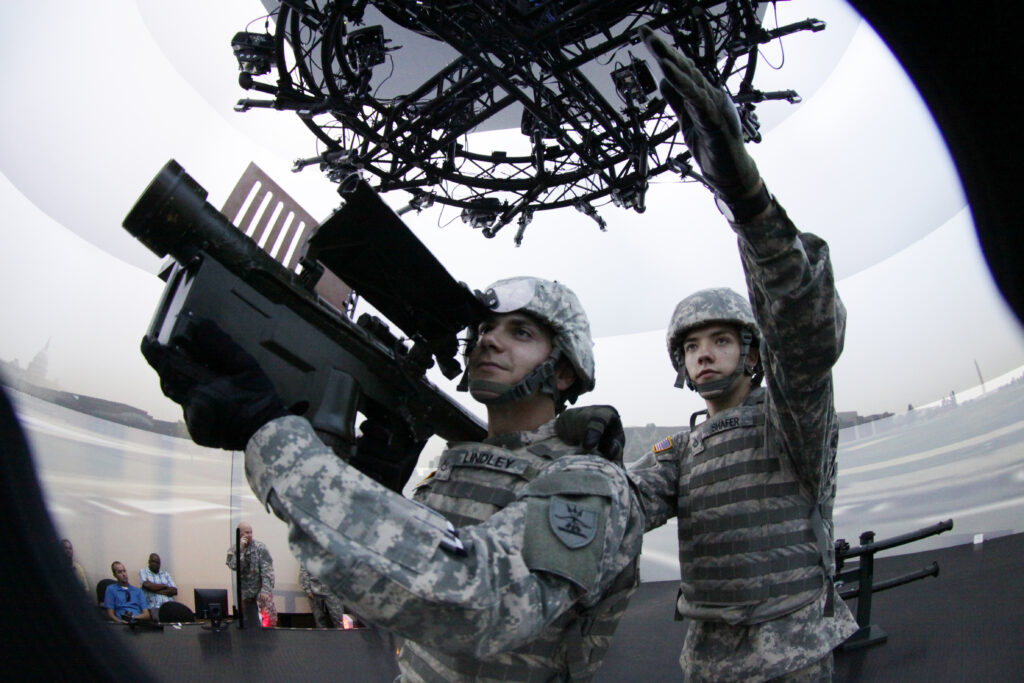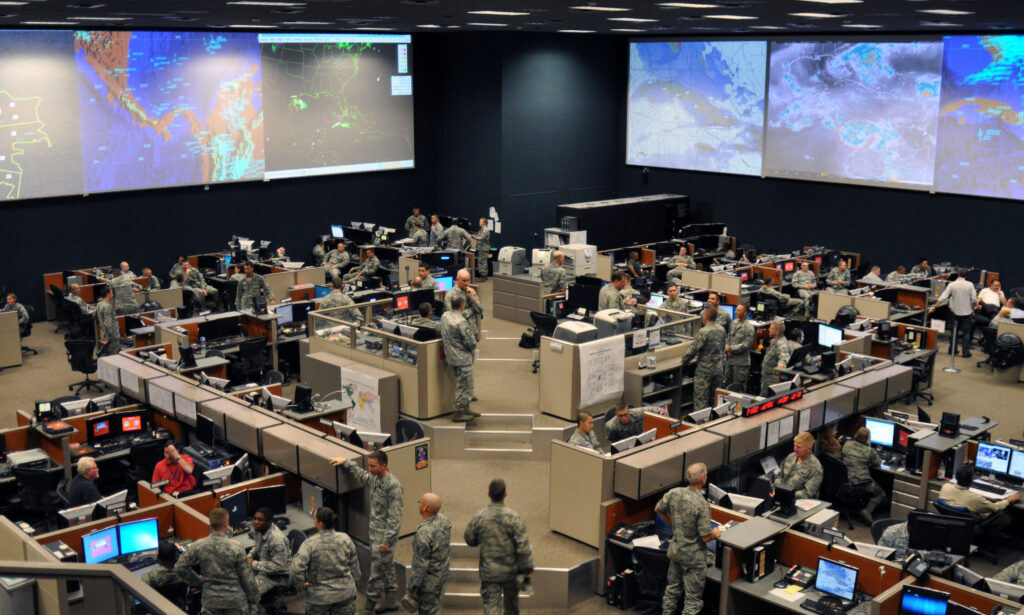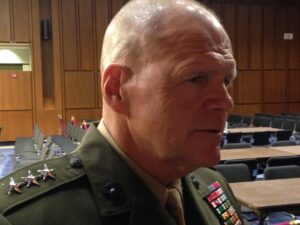
National Guard soldiers train with a Stinger anti-aircraft missile.
HUNTSVILLE, ALA.: Less than six months after its official rollout, the Army’s new concept of future warfare has gotten traction with all four armed services. In brief, Multi-Domain Battle envisions the military — everything from submarines to satellites, tanks to jets, destroyers to drones, grunts to hackers — working together to overwhelm the enemy with attacks from all domains: land, sea, air, space, cyberspace and the electromagnetic spectrum. While that vision is years from reality, it’s already spurred inter-service cooperation on how to make it real.

Defense Secretary Jim Mattis at his first meeting at the Pentagon. Robert Work is at the right.
This morning, the Association of the US Army kicks off a conference here in Huntsville with at least four panels focused on Multi-Domain Battle. That’s one more sign of how far the concept has come since it formally debuted at AUSA’s grand annual meeting in Washington, D.C., where it was publicly endorsed by a panel including
- Deputy Secretary of Defense Bob Work, the Pentagon’s most influential thinker about future warfare, who today is also the highest-ranking Obama official still in place;
- Air Force Chief of Staff Gen. David Goldfein, who earlier this month laid out in detail his own Multi-Domain Command & Control (MDC2) initiative, the first step towards a network that can connect the future force;
- Marine Corps Commandant Gen. Robert Neller, who rolled out his consciously similar Marine Corps Operating Concept that same fall and has made training more cyber/electronic warfare Marines a top priority; and
- Navy Adm. Harry Harris, head of Pacific Command, who since has since started a series of wargames to explore and refine Multi-Domain Battle.

Army ATACMS missile launch.
In fact, there’s already at least one weapon in the works directly inspired by Multi-Domain Battle: a version of the Army Tactical Missile System (ATACMs) modified to strike ships at sea. Both Adm. Harris — eager for every advantage against the growing Chinese fleet — and Army Chief of Staff Gen. Mark Milley have called for the Army to sink ships, and the Marines are interested as well. That’s a capability the ground services have lacked since the Coastal Artillery disbanded in 1950. Reviving it in the form of long-range precision missiles is the most dramatic and tangible example of the kind of change Multi-Domain Battle can bring — but it’s far from the only one.
Harris has also called for the Army and Navy to link their separate missile defense networks. That way Army radars could spot targets for Navy launchers and vice versa, creating a much tighter defense against North Korean, Chinese, or Russian missile salvos. It’s a technical feat Navy experts say is feasible.
Even more ambitiously, the Air Force’s Multi-Domain Command & Control initiative seeks to create a global network that can coordinate operations from all four services and from US allies. MDC2 would build to build on the existing system of Air Force-led Combined Air Operations Centers. These CAOCs, as Gen. Goldfein noted, already include large liaison contingents of soldiers, sailors, Marines, and allies, making them good foundations for further joint coordination.

Gen. David Goldfein
Today, a CAOC is “the one operational level headquarters that actually brings all the components together in a way you can integrate fires and effect,” Goldfein told the Air Force Association recently. When Goldfein himself was Air Component Commander in US Central Command, he said, he soon realized his role and that of the CAOC went far beyond just orchestrating air operations, complex as that was: “Actually, what we did was multi-domain operations.”
If you want to see what a next-generation CAOC might look like, consider the experimental Joint Interagency Combined Space Operations Center (JICSPOC), intended to keep America’s spy and communications satellites functioning under attack. “If there is a war on earth, we expect war to extend into space very early, that our [satellite] constellation will be under threat,” Work has said. “Right now, we don’t have the command and control or operational and organizational constructs to allow us to fight that constellation.” Work has praised JICSPOC as the leading model for future command-and-control. He’s particularly impressed by the potential for powerful computers — employing technologies like big data and even artificial intelligence — to pull together vast amounts of disparate data in forms that help human decision-makers instead of overwhelming them.

12th Air Force Combined Air Operations Center (CAOC).
More Than Technology
In its intense focus on what’s called C4 — Command, Control, Communications, & Computers — the Air Force is definitely on to something. C4 is crucial to future multi-domain operations. You can’t get disparate forces to work together unless they can communicate. But C4 is just the foundation, not the whole building, and technology is just one part of the solution.
Consider the Marine Corps’ distinctly different take on multi-domain operations. First, the Marine Corps Operating Concept issued last fall doesn’t use the term “multi-domain,” just then entering into vogue. Instead it speaks of “combined arms in all domains,” emphasizing not the novelty of the concept but its deep roots in traditional combined arms warfare.

General Robert Neller
The Marine concept also stresses the human aspects of conflict, including the need to reach out to local populations — not just in counterinsurgency, but as a source of intelligence against even advanced foes. Some thinkers, particularly in Special Operations, call this “the human domain,” elevating it to equal importance with land, sea, air, space, and cyberspace.
Like the Army with its anti-ship missiles, but even more so, the Marines also want to help the Navy, projecting power from land onto the sea. After all, “the seizure or defense of advanced naval bases” is a primary Marine Corps mission as defined by law. The new Marine concept specifically calls for the fleet to land Marines to establish forward airfields for F-35Bs, which in turn support the fleet — a multi-domain feedback loop from sea to land to air and back to sea again.
By contrast, the Navy has been supporting land forces non-stop since 9/11, and it’s just now returning its focus to fighting other navies for control of the high seas. That’s probably the reason why, with the exception of Admiral Harris, Navy leaders don’t talk much about multi-domain operations, at least in public.
That said, modern naval warfare is a multi-domain business in itself: submarines below the water, warships on it, aircraft above it, and satellites even higher above, with cyberspace and electromagnetic spectrum almost everywhere. Add Army and Marine Corps land-based missiles to strike enemy ships and shoot down enemy missiles, as Harris proposes, and you’re drawing on every domain. What’s more, the Navy has played the leading role in reviving the American military’s long-neglected electronic warfare capabilities and tying them to cyber operations, a crucial component of multi-domain battle.

Land-based missiles could form a virtual wall against Chinese aggression (CSBA graphic)
So what does the Army contribute to multi-domain operations? If the Air Force is in the lead on command and control, the Navy on cyber/electromagnetic warfare, and the Marines in the human domain, what does the largest service bring? To start with, the Army has been out in front advocating multi-domain battle as a broad concept, rather than focusing on a specific aspect. In white papers, online, and in public forums like AUSA, the Army has beaten the drum for “multi-domain” louder than any other service.
That’s not to say multi-domain battle emerged full-grown from the Army’s collective brain, like Athena from the head of Zeus. To the contrary: The concept has such appeal outside the Army because all the services were wrestling with similar ideas to solve the same problem. That problem is the proliferation of precision weapons — plus the sensors to target them and the networks to command them — to potential adversaries, especially to powerful nation-state militaries such as China and Russia. It’s often known by the Pentagon jargon Anti-Access/Area Denial (A2/AD) because such weapon-sensor-network systems could keep US forces from intervening in a regional crisis.
It was the Air Force and Navy that began conceptual work on cracking “A2/AD” with their Air-Sea Battle concept circa 2009. The Army and Marines, still consumed with Afghanistan and Iraq, came in later as junior partners. Then-Army Chief of Staff Ray Odierno also tried to create a counterweight concept, Strategic Landpower, that showed promise but never gained interservice traction — unlike multi-domain battle. The difference is that this time the Army has actually articulated a coherent and compelling framework for how all the services can help each other with their common problem.

German stosstruppen (storm troopers) on the attack in World War I.
Lethal And Chaotic
If I had to pick one specific insight of the Army’s as most important, it would have to be Gen. Milley’s cutting clarity about how lethally chaotic the future battlefield will be. Where American military thinkers once spoke of revolutions in military affairs, transformation, and achieving “dominance,” 16 years of grueling counterinsurgency and the resurgence of great power rivals have had a humbling effect.
Like the Revolution in Military Affairs theories of the 1990s, multi-domain battle emphasizes the power of networks, sensors, and precision weapons, but unlike the RMA, it expects no easy victories, only hard fighting. The Army’s mind in particular is concentrated by the prospect of facing the Russian bear again, a Red Army that’s lost in numbers but gained in missiles, rockets, drones, hacking, jamming, and overall sophistication both tactical and technical. The Chief of Staff’s remarks at last fall’s AUSA conference are indelible.
“On the future battlefield, if you stay in one place longer than two or three hours, you will be dead,” Milley said. “That obviously places demands on human endurance…Being seriously miserable every single minute of every day will have to become a way of life, (and) being surrounded will become the norm.”

Gen. Mark Milley
“The sheer volume and speed of conflicting information can easily bring decision-making to a screeching halt,” he said. “Of course that’ll only be a problem if the electronic systems even work…. There is a high probability, a certainty really, that anything electronic will come under cyber or EW attack.”
All told, “we are on the cusp of a fundamental change in the character of warfare, and specifically ground warfare,” Milley said. ” It will be highly lethal, very highly lethal, unlike anything our Army has experienced, at least since World War II.”
In 1914, “nations and empires marched off to their destruction, blind, blind to the changes in war,” said Milley. “Let us commit to not march into that abyss, blind to the changes. Let us commit for once, once in our history, to not be unprepared for that first battle.”
Taking aim: Army leaders ponder mix of precision munitions vs conventional
Three four-star US Army generals this week weighed in with their opinions about finding the right balance between conventional and high-tech munitions – but the answers aren’t easy.


























